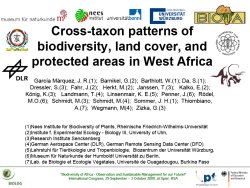|
|
|
 |
|
|
Presentation
< back to presentation overview
| Details of the presentation |
| Presentation |
Oral presentation |
| Title |
Cross-taxon patterns of biodiversity, land cover, and protected areas in West Africa
|
| PDF Download |
 Download PDF (Filesize 643 kByte)
Download PDF (Filesize 643 kByte)

|
| Short title |
Cross-taxon biodiversity patterns and protected areas
|
| Author(s) |
García Márquez, J.R.(1); Barnikel, G.(2); Barthlott, W.(1); Da, S.(1); Dressler, S.(3); Fahr, J.(2); Herkt, M.(2); Janssen, T.(3); Kalko, E.(2); König, K.(3); Landmann, T.(4); Linsenmair, K.E.(5); Penner, J.(6); Rödel, M.O.(6); Schmidt, M.(3); Schmidt, M.(4); Sommer, J.H.(1); Thiombiano, A.(7); Wegmann, M.(4); Zizka, G.(3)
|
| Presenting author |
García Márquez, J. R. (1)
|
| Institution(s) |
(1) Nees Institute for Biodiversity of Plants, Rheinische Friedrich-Wilhelms-Universität, D- 53115 Bonn, Germany; (2) Institute f. Experimental Ecology - Biology III, University of Ulm, D- 89069 Ulm, Germany; (3) Research Institute Senckenberg, D- 60325 Frankfurt am Main, Germany; (4) German Aerospace Center (DLR), German Remote Sensing Data Center (DFD), D- 97074 Würzburg, Germany; (5) Lehrstuhl für Tierökologie und Tropenbiologie, Biozentrum der Universität Würzburg, D- 97074 Würzburg, Germany; (6) Museum für Naturkunde der Humboldt Universität zu Berlin, D- 10115 Berlin, Germany; (7) Lab. de Biologie et Ecologie Végétales, Université de Ouagadougou, Burkina Faso
|
| Keywords |
cross-taxon biodiversity patterns, ecological niche modeling, West Africa, amphibians, bats, plants, protected areas, remote sensing, land cover
|
| Abstract |
Knowledge on species distributions and biodiversity patterns is a crucial pre-requisite for the development of sustainable conservation strategies. In an interdisciplinary approach, potential distribution ranges of bats, amphibians and plants are modeled across West Africa based on species locality information and environmental datasets. The spatial congruence of diversity patterns among animal and plant taxa is analyzed to pinpoint general as well as taxon-specific hotspots of diversity and endemism. This information is evaluated in the context of current land cover and degradation as well as the existing network of protected areas to identify gaps and to highlight irreplaceable regions for the long-term conservation of biodiversity.
|
| Congress Topic |
Interventions
|
| Topic No. |
4.1 |
| Notes |
---
|
| Ref. No. |
546 |
|
|
|
